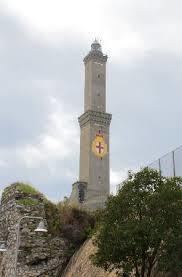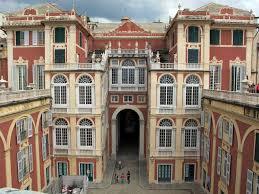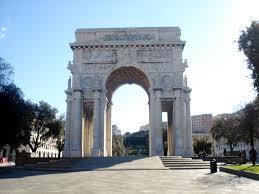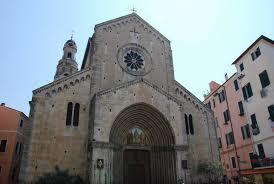10 historical monument in Genova
The lantern
The lantern served as a luminous reference for boats at night. It is 117 m high. and nearby is the Lanterna Museum containing a special lens, called Fresnel, which reproduces the vision of a real lighthouse seen from an internal perspective. The lantern is today a symbol of the city and climbing on the lantern you have a magnificent view of the city.

Cathedral of San Lorenzo
The Cathedral of San Lorenzo which houses the Sacred Basin.
This cathedral was consecrated in 1118 by Pope Gelasius II Gaetani and according to the legend San Lorenzo and Pope Sixtus II lodged there. Inside the church we can admire not only the relics but also numerous gothic and paintings realized between the end of the XIII century and the beginning of the XIV, not to be missed also the treasure museum of San Lorenzo.
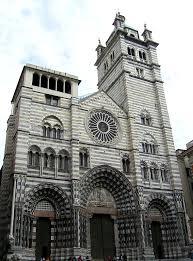
Palazzo San Giorgio
The palace was built around 1260 at the behest of Guglielmo Boccanegra, the palace from the seat of the Municipality to the prison in fact it was the place where Marco Polo was re-closed, and I commissioned the famous Milione. The building consists of two parts, an older part for medieval architecture and a Renaissance one where the main entrance is located. this is one of the most famous historic buildings in Genoa.

Catello d 'Albertis
The castle was built in 1886 in negotico style, located from the top of the Montegalletto hill, overlooking the city of Genoa with a breathtaking view.
The castle's style and structure were designed by Captain Enrico Alberto D'Albertis, who then chose it as his home. At his death in 1932, the Captain donated Castello D'Albertis to the city of Genoa.Since then Castello D'Albertis has hosted the Museum of World Cultures, where you can admire the collection of objects that D'Albertis brought to Genoa from his many journeys by sea and by land as a testimony to the charm of distant worlds.

Palazzo dei Rolli
The Palazzi dei Rolli are a group of noble palaces that, at the time of the ancient Republic, were obliged, on the basis of a public draw from the lists of public housing (called "rolli"), to host the high personalities who were in Genoa in state visit. They include a series of late-Renaissance and Baroque buildings that normally have three or four floors "with spectacular open staircases, courtyards and arcades overlooking gardens". Many of the interiors, despite the passing of the centuries and the heavy damages due to the bombings of the Second World War, present the original decorations of the major authors of the Mannerist and Genoese Baroque.

Victory Arch
The square was so named to celebrate the end of the First World War, Piazza della Vittoria is one of the fulcrums of the city center, the shopping street, connecting Piazza della Vittoria to the central Piazza De Ferrari. At the center of the Piazza stands the Arco della Vittoria, monument erected in the 1930s in honor of the fallen of the First World War.In a perspective game with the triumphal arch of Piazza della Vittoria, the staircase of the Unknown Soldier, better known as the staircase of the Caravels for the image of the three ships of Columbus depicted in the grass, framing Piazza della Vittoria, leading to the hill of Carignano.

The Torre dei Morchi
The Torre dei Morchi, dating back to the 12th century is located in Piazza Caricamento. In the XIII century Genoa was a towered city, 66 towers could be counted. Today very few of them remain intact, most have been demolished or incorporated into adjacent buildings. The Torre dei Morchi is similar in structure and materials to that of the Embriaci, built with large blocks of ashlar stone and at the top is crowned by a triple frame of hanging arches that are ever more protruding.
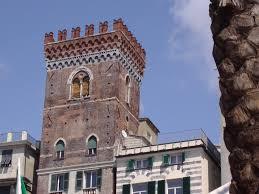
The House of Columbus
The building is on two floors, while the facade was restored during the seventeenth century. The ground floor was used as a workshop for his father, who was involved in weaving wool and trading. Recent excavations, carried out during restoration works, have brought to light ancient foundations of a building dating back to before the Middle Ages, probably in the 6th century.

Monumental Cemetery of Staglieno
The Monumental Cemetery of Staglieno. Always located in the Ligurian capital, this cemetery is certainly one of the most important monumental cemeteries in Europe. With an area of more than 330 square meters, the structure is considered an open-air museum; includes an English cemetery, a Protestant cemetery and a Jewish cemetery and houses tombs of famous people such as Giuseppe Mazzini, Gilberto Govi and Fabrizio De Andrè. There are also numerous sculptures and statues, mainly made by Genoese artists and distributed throughout the territory.

Castle of the Stone
This ancient building that seems to have been dug directly into the rock is one of the major attractions of the Genoese hinterland: located in the municipality of Vobbia, in the Scrivia Valley, and attraction of the Antola Natural Park, the Castello della Pietra should go back, according to some hypothesis, to 1100 and passed from the property of the Della Pietra, to the Spinola, to the Adorno up to the donation to the Commune of Vobbia. Today it is possible to visit it

5 historical monument in the samll country in Liguria
Cathedral of San Siro Sanremo
The Cathedral of San Siro, in late Romanesque style, modified several times over the centuries, dates back to the early twelfth century.
The building, expanded also in 1916, has a plan with three naves supported by a double row of circular columns (only a few are polygonal), surmounted by pointed arches. The current façade is characterized by a large ogival portal with splayed forepart.

The Villa Matutina Sanremo
The Villa is an archaeological site with the remains of a noble residence from the Roman era and with a thermal complex attached.
It belongs to the typology of maritime villas and was built between the 1st and 2nd century AD by the sea, a place chosen for its beauty, where to stop and rest enjoying the spectacle of nature.
the entire built-up area, which is much larger than the part that can be visited and extends under the current sea level

Villa Grock Imperia
Villa Grock and its park, built on the will and project of "Grock", stage name of the Swiss Adrien Wettach. Villa Grock was used as the location of the Festival venue for events and shows.

Basilia of San Maurizio
The structure stands out for its majesty and sense of power with its entrance columns, topped by two bell towers. the interior has a Latin cross shape, its style is typical of neoclassicism.The Basilica of San Maurizio is certainly one of Imperia's flagships. Every day is visited by many tourists fascinated. Accessible only for certain events with guided tours. From up there you can admire the whole city from border to border.

Church of Santa Maria Maddalena
Located in the central Piazza del Popolo, the Church of Santa Maria Maddalena is one of the most important Catholic (Roman rite) religious buildings in Bordighera, in the province of Imperia, seat of the Vicariate of Bordighera. The church has a very simple façade, two orders and with a rose window above the portal.

What to see in Umbria?
Monuments, restaurants and local foods
How to enjoy Clermont-Ferrand
Clermont-Ferrnad, located in Auvergne a green and peaceful region, is the perfect place if you want to discover France in an unusual way.
Morocco by car
Morocco by car. The full itinerary of a car trip in Morocco.
Road trip: 15 days accross Europe
Go through 4 different countries and visit new places, cultures and ways of life in a 12 days road trip accross Europe.

